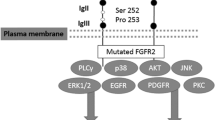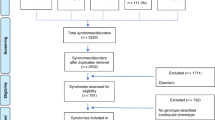Summary
A newborn girl is reported with seemingly typical Apert syndrome with preaxial polysyndactyly of the feet. As a result of reevaluation of familial cases of acrocephalosyndactyly with polysyndactyly, acrocephalosyndactyly is suggested to be divided into two major groups. Apert-Pfeiffer type (acrocephalosyndactyly type I) is characterized by Crouzon-like facies, hallux varus and severe syndactyly. Saethre-Chotzen/ Robinow-Sorauf type (acrocephalosyndactyly type II) is characterized by Saethre-Chotzen facies, hallux valgus and mild syndactyly. Each type should have atypical forms with polysyndactyly due to pleiotropic effect of a dominant gene.
Similar content being viewed by others
Log in or create a free account to read this content
Gain free access to this article, as well as selected content from this journal and more on nature.com
or
References
Carter, C., Till, K., Fraser, V., and Coffey, R. 1982. A family study of craniosynostosis, with probable recognition of a distinct syndrome.J. Med. Genet. 19: 280–285.
Cohen, D.M., Green, J.G., Miller, J., Gorlin, R.J., and Reed, J.A. 1987. Acrocephalopolysyndactyly type II — Carpenter syndrome: clinical spectrum and an attempt at unification with Goodman and Summitt syndromes.Am. J. Med. Genet. 28:311–324.
Escobar, V. and Bixler, D. 1977. On the classification of the acrocephalosyndactyly syndromes.Clin. Genet. 12: 169–178.
Kopyść, Z., Stańska, M., Ryzko, J., and Kulczyk, B. 1980. The Saethre-Chotzen syndrome with partial bifid of the distal phalanges of the great toes: observation of three cases in one family.Hum. Genet. 56: 195–204.
Maroteaux, P. and Fonfria, M.C. 1987. Apparent Apert syndrome with polydactyly: rare pleiotropic manifestation or new syndrome?Am. J. Med. Genet. 28: 153–158
McKusick, V.A. 1988.Mendelian Inheritance in Man: Catalogs of Autosomal Dominant, Autosomal Recessive, X-Linked Phenotypes, 8th Ed., The Johns Hopkins University Press. Baltimore and London.
Noack, M. 1959. Ein Beitrag zum Krankheitsbild der Akrozephalosyndaktylie (Apert).Arch. Kinderheilk. 160: 168–171.
Pfeiffer, R.A. 1969. Associated deformities of the head and hands.Birth Defects Orig. Art. Ser. V(3): 18–34.
Robinow, M. and Sorauf, T.J. 1975. Acrocephalopolysyndactyly, type Noack, in a large kindred.Birth Defects Orig. Art. Ser. XI(5): 99–106.
Temtamy, S.A. 1976. (cited by McKusick, V.A., 1988).
Young, I.D. and Harper, P.S. 1982. An unusual form of familial acrocephalosyndactyly.J. Med. Genet. 19: 286–288.
Author information
Authors and Affiliations
Rights and permissions
About this article
Cite this article
Izumikawa, Y., Naritomi, K., Ikema, S. et al. Apert syndrome with partial polysyndactyly: A proposal on the classification of acrocephalosyndactyly. Jap J Human Genet 33, 487–492 (1988). https://doi.org/10.1007/BF01897790
Received:
Accepted:
Published:
Issue date:
DOI: https://doi.org/10.1007/BF01897790



